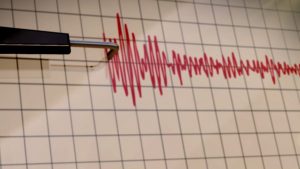Humanshu Thakkar
Ganga Basin, particularly Bihar is facing unprecedented floods, starting on Aug 12, 2017. Water levels of Major tributaries of Ganga, including Kosi, Mahananda, Rapti, Bagmati, Gandak and Kamlabalan are close to or above the historically highest flood levels almost simultaneously. This has rarely happened in the past. The water level of Ganga itself is close to HFL at Elgin Bridge in Barabanki district in Uttar Pradesh. Most other flood forecasting sites in North Bihar and East UP were shown as pink dots on CWC flood forecasting map on Aug 13-15, signifying that water level at these sites was above the danger level.
This is possibly the beginning, this wave is expected to rise as it travels down towards Bihar and then W Bengal and Bangladesh.
As I wrote on the unprecedented Brahmaputra flood wave on Aug 12, from Aug 11 morning, the purple patch (signifying rainfall in excess of 175 mm rainfall in previous 24 hours) on NASA daily Rainfall accumulation map[i] on Brahmaputra basin travelled west to Ganga basin in next two days.
Such purple patches generally disappear in 24 hours, since the rains do not last too long. However, in the case of the current phase, the purple patch lasted for about 48 hours over large parts of Ganga basin, all along India Nepal border region along the southern boundary of Nepal.
One does not see any reflection of this on CWC of India (Central Water Commission) flood forecasting site[ii], their forecasts continue to come a few hours in advance at best, and even those proved substantially erroneous or inaccessible.
Both the flood forecasting sites of the Mahananda river, namely Dhengraghat and Jhawa, crossed their respective HFLs of 1968 and 1987. This means that the Mahananda River water level broke the almost 50-year-old record at Dhengraghat and 30-year-old record at Jhawa. At Jhawa, the HFL is at least 53 cm higher than the previous HFL, such jump in HFL is very rare indeed. The Dhengraghat HFL rise of 11 cm is nearer to usual. The water level rise at Jhawa was also unusually rapid.
The Kosi river water level was, in fact, the first one in Bihar this season to breach the HFL at night on Aug 12. This led to breach in embankments, as well known Flood expert of Bihar, Dr Dinesh Mishra reported. This possibly has delayed the arrival of this water to downstream flood forecasting sites along Kosi River. However, on 15th Aug, Baltara on Kosi River also entered the site where the water level was within 0.5 m of HFL.
The Gandak River crossed HFL at Dumariaghat in Gopalganj district, while Rapti river in Ghagra basin crossed HFL at Balrampur, and both remain above HFL and show rising trend as I write this. Bagmati River at Benibad and the Kamlabalan River at Jhanjharpur remained shown as an orange dot on CWC flood forecasting site (signifying that River water level was within 0.5 m of the HFL for respective sites) but did not cross HFL, partly because of the breach of embankments on these rivers. The full impact of the breach of these embankments is not known, and possibly will never be known, but anecdotal news shows that the impact is huge and devastating.
Upstream dams like the Bansagar in Sone basin in Madhya Pradesh (which triggered the Aug 2016 flood disaster in Bihar by suddenly releasing huge quantity of water while downstream river was in floods due to heavy rains) and Tehri in Uttarakhand are almost full and could add to the crisis if they decide to release large quantities of water.
The cumulative impact of all these floods is bound to travel to Ganga, even though rains have decreased in catchments of Ganga tributaries. The role of Farakka barrage on Ganga River, in creating siltation, drainage congestion and backwater flood is once again likely to come into sharp focus in days to come, like the way it happened in Aug 2016. Bihar Chief Minister Nitish Kumar, heading a Mahagathbandhan govt last year blamed Farakka for the flood crisis in Bihar. Let us see how he responds this year, now that he heads an NDA govt, which is also in power at the centre.
The floods also created extensive damage in Nepal, the full details are not yet known. Media earlier reported at least 36 deaths in Nepal[iii], among other damages.
Brahmaputra At Goalpara (Assam) site in Goalpara district on the main stem of Brahmaputra (HFL of 37.43 m reached on 31.07.1954, possibly the oldest standing HFL record), the river water reached the level of 37.02 m (Steady trend) at 1200 hrs on Aug 15, 2017 and is forecast to remain at this level till 0600 hrs on Aug 16, 2017.
At Dhubri (Assam) site in Dhubri district on the main stem of Brahmaputra (HFL of 30.36 / 28.8.1988), the river water reached 29.87 m (steady trend) at 2100 hrs on Aug 15, 2017, and is forecast to remain at this level till 0600 hrs on Aug 16, 2017.
These are the 8th & 9th sites in Brahmaputra basin, where river water level has reached within 0.5 m of HFL for that site, the list of seven earlier sites is given in our report[v] dated Aug 12, 2017. Large parts of Assam, North Bengal and other parts of Brahmaputra basin continues to remain flood impacted.
Bangladesh flood forecasting website (http://www.ffwc.gov.bd/), however, provides, for each of its flood forecasting location, a graph that shows the actual water observation for the past week and also the forecast for the next five days.
In Bihar as per some media reports[vi], 41 people have already died, 25 districts are affected, 1.79 lakh ha cropped land is damaged, 3200 villages are inundated and 31 lakh people have been affected. These figures are likely to rapidly go up.
(Himanshu Thakkar is leader of the South Asia Network on Dams Rivers and People (SANDRP), The story has been excerpted from his post uploaded at the SANDRP website)



